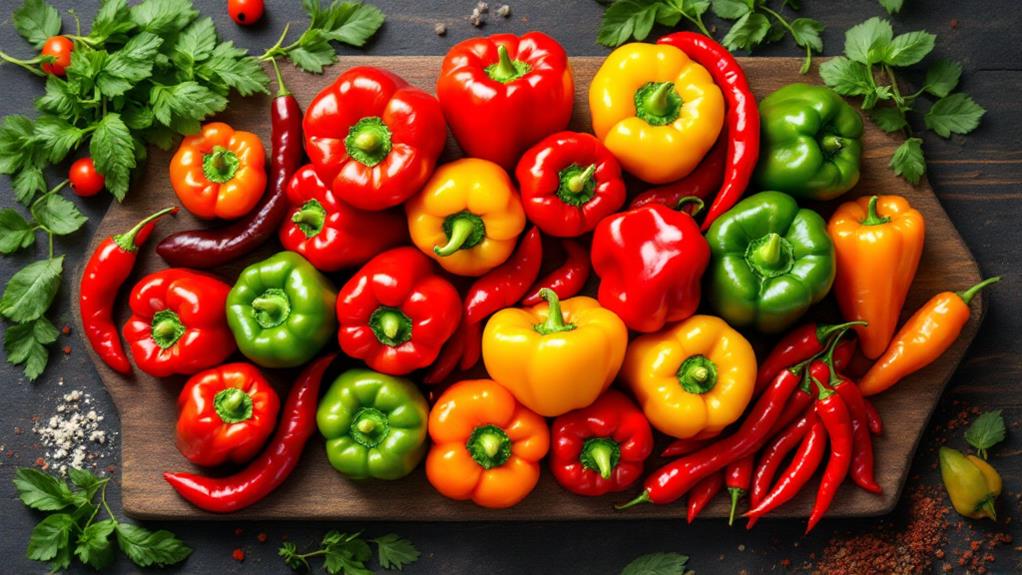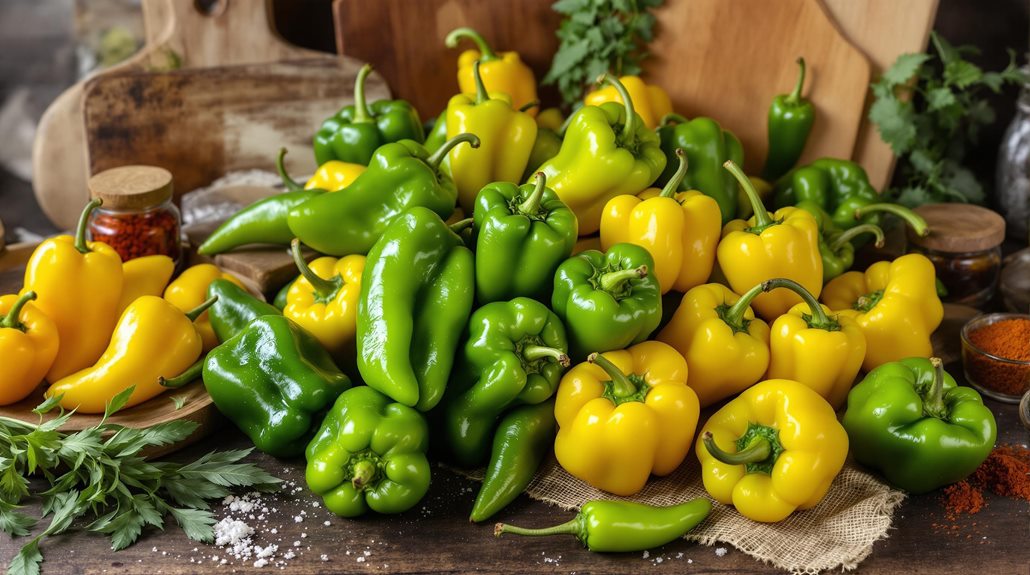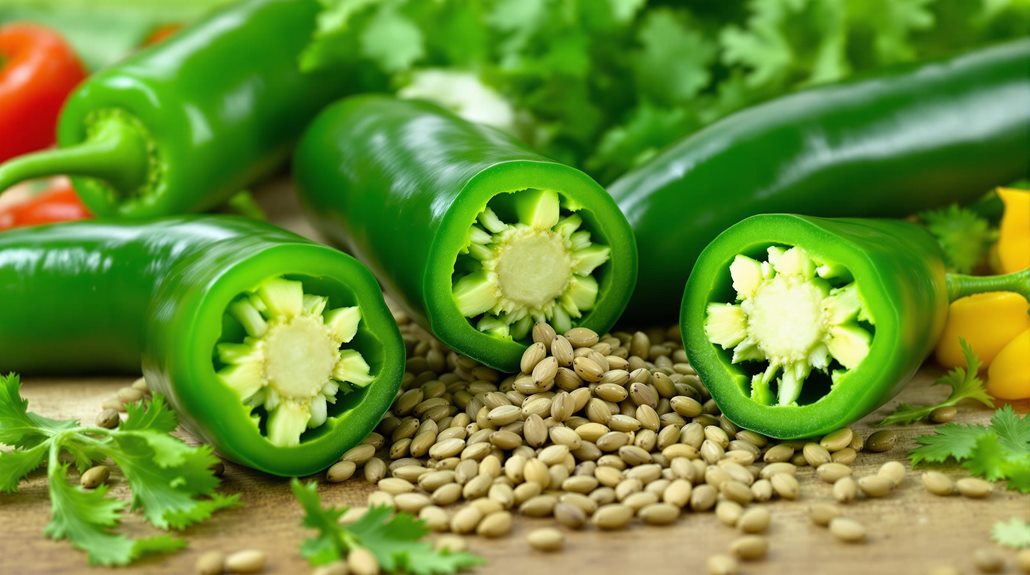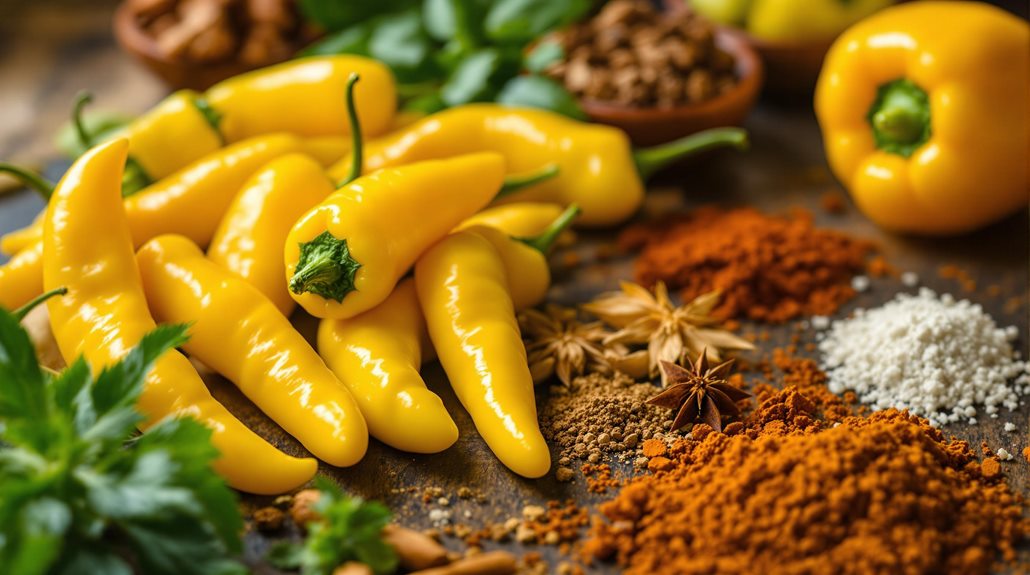The Health Benefits of Different Types of Peppers: A Spicy Guide

Incorporating peppers into your diet offers outstanding health benefits. Peppers are packed with vitamin C, enhancing your immune system, while capsaicin in spicy varieties elevates metabolism and aids weight loss. You may notice improved heart health as capsaicin promotes better blood circulation and reduces heart disease risk. Suffering from pain? Capsaicin can provide relief from migraines, arthritis, and fibromyalgia. With low calories, peppers enrich your diet without extra weight. Trying out peppers in recipes can add bold flavors and nutritious value. Investigate more to uncover how different peppers can transform well-being and enrich culinary experiences.
Nutritional Value of Peppers
In terms of nutrient density, peppers truly shine. You might be surprised to learn that chili peppers boast exceptionally high vitamin C levels, with red peppers containing three times the vitamin C of medium oranges. This makes them a powerful source of antioxidants, vital for combating free radicals and supporting your immune system. The impressive nutrition doesn't stop there—peppers are also rich in vitamins A, E, K, and B6, and important minerals like potassium and magnesium, all contributing to your comprehensive health.
Hot peppers, in particular, contain capsaicin, a compound that can enhance your metabolism and aid in weight loss. Capsaicin works by increasing thermogenesis, the process by which your body burns calories to produce heat, and by reducing your appetite. This makes peppers a smart choice if you're looking to manage your weight while enjoying a flavorful diet.
Moreover, the antioxidants and polyphenols found in both sweet and hot peppers are linked to eye health and have potential cancer-fighting properties. With their low-calorie profile, peppers offer significant health benefits without adding extra calories, making them a tasty and nutritious supplement to your meals.
Pain Relief With Capsaicin
Beyond their nutritional prowess, peppers offer remarkable benefits in pain relief, primarily due to the presence of capsaicin. This powerful compound, found in chili peppers, can numb the trigeminal nerve, offering significant relief from migraine pain. Studies show that 70% of participants experience total relief from different headache types. If you struggle with chronic pain conditions, capsaicin might be your ally. By altering pain signals, it tricks your brain into perceiving heat rather than pain, which can be incredibly beneficial.
Topical applications of capsaicin creams are a popular alternative to traditional pain medications. They've been shown to reduce discomfort from arthritis and fibromyalgia by up to 50%. Imagine being able to manage your pain without solely relying on over-the-counter pain relievers. Capsaicin is also utilized in medical formulations to alleviate pain from muscle sprains and post-surgery recovery. To optimize its benefits, frequent reapplication is key—this boosts effectiveness and provides sustained relief for persistent discomfort.
Embrace the spicy power of capsaicin for pain relief. Regardless of whether it's migraine pain, arthritis, or fibromyalgia, capsaicin might just be the natural solution you've been searching for.
Metabolism and Weight Control

Regarding metabolism and weight control, capsaicin in hot peppers can be your secret weapon. This spicy compound can increase your body temperature, which in turn elevates your metabolic rate and calorie expenditure. By incorporating chili peppers into your meals, you can take advantage of these weight management benefits. Research suggests that capsaicin can help control appetite and reduce fat accumulation, making it a valuable component in your weight management arsenal.
Here's how chili peppers can aid in weight management:
- Increases Metabolic Rate: Capsaicin raises body temperature, leading to a higher metabolic rate and more calories burned after consumption.
- Improves Calorie Expenditure: Consuming capsaicin regularly can add an extra 50 calories burned during digestion, aiding weight loss over time.
- Facilitates Fat Oxidation: Capsaicin has been shown to improve fat oxidation during exercise, helping you get more from your workouts.
While these spicy benefits are promising, it is crucial to acknowledge that the long-term effects of capsaicin on sustained weight loss are still under investigation. Nonetheless, adding a bit of peppery heat to your diet could be a step towards better weight management.
Peppers for Heart Health
The fiery kick of hot peppers goes beyond just adding flavor to your meals; it plays a significant role in promoting heart health. Capsaicin, the active compound found in chili peppers, is a powerful ally for your cardiovascular system. It improves blood circulation and flow, which are vital for maintaining a healthy heart. Regular consumption of chili peppers has been linked to a remarkable 74% reduction in cardiovascular mortality, showcasing their protective benefits.
Capsaicin targets inflammation, a primary risk factor for heart disease, by minimizing the harmful effects of LDL cholesterol in your body. This reduction in bad cholesterol levels can greatly lower your risk of heart-related issues. Furthermore, studies have shown that indulging in spicy food correlates with fewer heart attacks and improved heart function, underlining the importance of incorporating peppers into your diet.
Additionally, the activation of TRPV1 by capsaicin provides further cardiovascular protection. This process could potentially aid in preventing and managing heart disease. By including chili peppers in your meals, you're not just spicing up your plate, but actively contributing to better heart health and longevity. Welcome the heat for a healthier heart!
Culinary Uses and Tips

For those looking to explore the world of peppers in the kitchen, these lively ingredients offer endless possibilities. Regardless of if you're a fan of sweet peppers or hot peppers, there's a place for them in your culinary adventures. Sweet peppers, like bell peppers, are a colorful enhancement to salads or as crunchy snacks. They add vibrancy to your food without the heat, making them perfect for everyone. On the other hand, hot peppers such as jalapeños and serranos can boost your dishes with a spicy kick, ideal for sauces, marinades, or stir-fries.
To make the most of these versatile ingredients, consider the following culinary uses and tips:
- Stuffed Peppers: Use a variety of fillings like grains, legumes, or vegetables for a nutritious meal.
- Homemade Chili Oil: Infuse neutral oil with crushed chili flakes for a flavorful condiment.
- Handling Hot Peppers: Wear gloves to prevent irritation, and use dairy products to neutralize heat if needed.
Don't hesitate to experiment with spicy foods! You can create bold new flavors with these peppers, enhancing your dishes and delighting your taste buds. Enjoy the expedition of uncovering new culinary uses!




